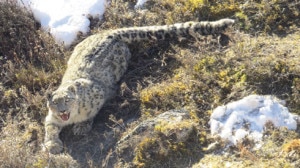(English) WWF mistakenly radio-collars same big cat


KATHMANDU, Nepal– With a technical team spread by the government and its development partners ´mistakenly´ fitting a satellite-based tracking device on the same big cat, all the efforts spent in the radio-collaring of a snow leopard late last year in Kanchanjunga Conservation Area (KCA) located in the eastern region of Nepal have gone in vain.
In November last year, a team of technicians from the Department of National Parks and Wildlife Reserve (DNPWC), the World Wildlife Fund (WWF) and the National Trust for Nature Conservation (NTNC) had trapped a big cat in KCA. The trapped leopard was fitted with a Global Positioning Satellite (GPS) collar and released in Khambache of Kanchanjunga area.
After five months, the DNPWC, the WWF and the NTNC spread a technical team again in KCA. The team, led by the WWF´s senior research officer Kamal Thapa, was assigned with trapping and fitting a GPS collar on a new snow leopard. Unfortunately, Thapa´s team trammeled the same big cat and released it after fitting a new GPS collar on it.
With an aim to study habitat and behavior of snow leopards, DNPWC, WWF and NTNC had planned to fit GPS collars on snow leopard. Thapa´s team was anticipated to fit GPS collar on at least one more snow leopard. But, trapping and collaring of the same cat has led to wasting of enough amount and time.
“… we could not trap a new big cat. After one month of camping in high altitude, we trapped a snow leopard but that was the same as trapped in last November. I saw the old GPS collar getting loosened and rusting. So, I replaced it with a new GPS collar”, Thapa was quoted by a broadsheet Nepali daily.
How did it happen?
The GPS collar fitted in November last year was even functional and did not need to be replaced at all. Normally, battery of such GPS devices lasts for one year. And, hardly six months had passed when the old GPS collar was cast out.
Dr Maheshwor Dhakal, spokesperson for DNPWC, said they should have had at least two big cat fitted with radio collars in Kanchenjunga area by now. He also said they were investigating the case which led to the serious error.
In last November, snow leopard was caught early in the morning; and it was radio-collared in day light. The same leopard was caught in the evening and it was radio-collared in the dusk in mid-May of this year.
